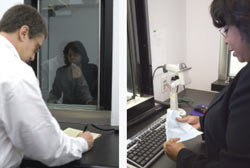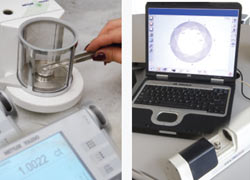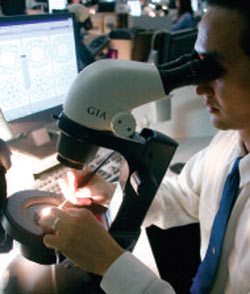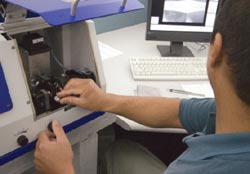Contact
Click below to speak to a Diamond Consultant or customer service.
or
Live Chat8:00 am - 6:00 pm CST (Mon - Fri)

Click below to speak to a Diamond Consultant or customer service.
or
Live Chat8:00 am - 6:00 pm CST (Mon - Fri)
Diamonds are submitted for GIA certification by the diamond's current owner (usually the diamond cutter or dealer, but often a retailer or sometimes even the end consumer).

The grading process begins when the diamond arrives at the GIA lab. It might be delivered from anywhere in the world by courier or submitted in person by the owner. A member of the GIA client services staff accepts hand-delivered submissions through a secure booth.
The submitted diamond may not include any company names, initials, logos, or other information that would allow GIA personnel to identify the owner during the grading process. This allows GIA to avoid the appearance of favoritism, and insures an objective grade. The submitted diamond is assigned its own internal tracking number and placed into a transparent storage case. The tracking number identifies the diamond as it makes its way through the grading process.

The first step in the certification process is for the diamond to be weighed and measured. An electronic micro-balance captures the carat weight, while an optical scanning device is used to determine the diamond's precise measurements, proportions and facet angels. These devices are more accurate than the manual gauges you might see in a jewelry store or appraiser's office.
An additional review is done to determine whether the submitted gem is a synthetic diamond or a simulant, or if the diamond's color is lab induced rather than natural. If necessary, the gem may be sent for further testing to determine is chemical composition and origin of color.
The diamond's clarity and finish are graded under magnification using standard viewing conditions, and multiple graders. The first grader examines the diamond to locate any clarity and finish characteristics as well as evidence of treatments such as fracture filling or laser drilling. At the same time, the grader verifies all weight and measurement data captured in the prior step.

The grader then assigns an opinion of the diamond's clarity, polish and symmetry. If the diamond is to receive a full grading report (as opposed to a dossier), a diamond plot is also created, mapping the diamond's interior and exterior flaws. In it, the grader indicates the size, position, and nature of each clarity characteristic. Finally, the diamond's culet size and girdle thickness are also assessed.
A second grader then takes the diamond through the same process, once again identifying each clarity characteristic, evaluating the polish, symmetry, culet, and girdle, and checking for the presence of any treatments. This grader then submits a second independent opinion of the diamond. Depending on the diamond's carat weight, quality, and the degree of agreement between graders, a senior gemologist may review the previous grading information and render a third opinion. Grading results are finalized once there is sufficient agreement on grades.

Next, the diamond's color is compared to a set of master stones. The master stone set is a row of stones laid out from D to Z, representing the standard for each color grade. Each stone represents the least amount of color in its range. By moving the submitted diamond step by step down the line of master stones, the grader is able to determine where the submitted diamond falls in the color grade spectrum. The grader next observes the diamond under special UV lighting to see if the diamond exhibits signs of fluorescence; and if so, to what degree.

Every diamond is judged by several graders to insure that accurate color and fluorescence grades are assigned. Each grader is unaware of the opinions of the other graders. Only when there is sufficient agreement between individual graders is a color grade assigned. Since light source and background can have a significant impact on the appearance of color within a diamond, the grading environment is kept to a neutral gray and white.
For round brilliant diamonds, a cut grade is assigned once the color and clarity grading process is complete. The diamond's brightness, fire, and scintillation are assessed and incorporated into the cut grade. The diamond's measurements, proportions, facet angles, polish, and symmetry are also factored into the final cut grade.
As diamonds move through the grading process, they are monitored by a central tracking department using electronic surveillance equipment which can pinpoint the diamond's exact location at any time. Upon completion of each grading step, diamonds return to the inventory control department before being sent to the next step. This insures that the distribution of diamonds to graders is completely random.

Every diamond receiving a diamond dossier certificate is laser inscribed with the GIA certificate number. Diamonds receiving a full grading report can also be laser inscribed at the owner's request. Any laser inscription is noted on the certificate itself.
Once the grading process is complete, GIA issues the diamond's certification. The report is printed with micro print lines, a hologram, and other security components before being laminated. This helps to prevent tampering while preserving the certificate over time. The final report is then placed in a protective sleeve and delivered to the owner, along with the originally submitted diamond.
Questions about the certification process? Ask a diamond consultant for answers. A consultant will answer any questions you have, and if you like, search on your behalf for diamonds that match your criteria. chat online, or email [email protected].

